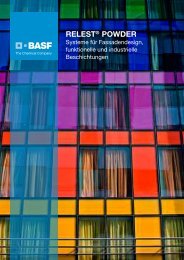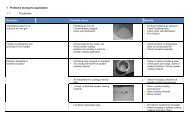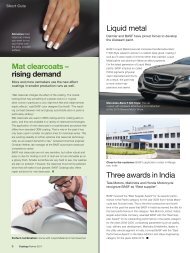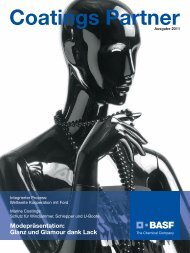lines love curves - BASF Coatings
lines love curves - BASF Coatings
lines love curves - BASF Coatings
You also want an ePaper? Increase the reach of your titles
YUMPU automatically turns print PDFs into web optimized ePapers that Google loves.
one e-coat tank per month is currently being<br />
changed over to CathoGuard 800. “Whether<br />
it’s in the USA, Europe, South America or<br />
Asia Pacific, the demand is overwhelming.<br />
It’s a huge success for us,” said Stefan Wittemann,<br />
product manager for e-coat and<br />
primer in Europe. “Together with our customers,<br />
we will continue to strive for environmentally<br />
friendly and sustainable product<br />
solutions in the future. With CathoGuard 800<br />
and 900, <strong>BASF</strong> offers this type of solution<br />
and it will be used in automotive production<br />
even more often in the future.“<br />
E-Coating<br />
40 years of success<br />
Early 1960s: Anodic e-coating replaces<br />
conventional dip coating. With this<br />
process, the body and the coating are<br />
electrically charged, with the body<br />
receiving a positive charge and the<br />
coating a negative charge.<br />
Mid-1970s: With cathodic e-coating,<br />
the poles are reversed.<br />
Late 1970s: <strong>BASF</strong> supplies the paint for<br />
the first e-coating line for small parts<br />
ever used in the European automotive<br />
industry.<br />
Late 1980s: <strong>BASF</strong> launches the<br />
CathoGuard ® technology. The product‘s<br />
exceptional features include its<br />
optimized edge protection, flow and<br />
throwing power. CathoGuard 300 to<br />
500 were the first lead-free e-coating<br />
products.<br />
Today: CathoGuard 800 and 900 are<br />
tin-free, have a low percentage of<br />
solvents (low VOC), are HAPs-free and<br />
conform to the latest requirements of<br />
environmental legislation.<br />
in many key markets, <strong>BASF</strong> has already<br />
successfully launched CathoGuard 800, the<br />
latest e-coat generation.<br />
intERviEw<br />
More than mere rust<br />
protection<br />
Oliver Johannpoetter, project manager for the CathoGuard ® 800<br />
technology at <strong>BASF</strong>, explained the special properties of the new<br />
e-coat products and what makes them so successful.<br />
How does e-coating work?<br />
During e-coating, the bodies literally take<br />
a bath in order to take on a primer coat.<br />
The body, which has been cleaned and<br />
pretreated, is dipped in an e-coating tank,<br />
which often contains up to 400,000 liters.<br />
In the tank, the body and the coating are<br />
electrically charged – with the body<br />
receiving a negative charge, and the<br />
coating a positive charge. The coating is<br />
evenly deposited on the body. The body is<br />
then rinsed off and the remaining paint is<br />
baked at about 180 degrees Celsius.<br />
What are the advantages of CathoGuard<br />
800 and 900?<br />
CathoGuard 800 and 900 are absolute<br />
high-performance products that combine<br />
numerous advantages. Their performance<br />
goes far beyond mere rust protection.<br />
They offer an excellent basis for the<br />
application of the subsequent paint layers<br />
and protect edges and cavities from<br />
corrosion and stone chipping – even for<br />
highly complex automotive parts. In<br />
addition, the new generation of e-coats is<br />
especially environmentally friendly. They<br />
are low in solvent content, they contain no<br />
heavy metals and dispense with hazardous<br />
air pollutants. CathoGuard 800 and<br />
900 are therefore HAPs-free, containing<br />
no chemicals on the U.S. Environmental<br />
Protection Agency’s hazardous air<br />
pollutants list, and already comply with<br />
future European legislation today.<br />
Another important advantage is that the<br />
optimized distribution of the film resulting<br />
in a homogenous thickness saves<br />
material. The multi-metal compatibility of<br />
the new CathoGuard generations means<br />
fewer touchups on the body and high<br />
quality and process reliability in production.<br />
In addition, the coating does an<br />
outstanding job on any substrate and<br />
can be combined with state-of-the-art<br />
pretreatment methods, including the new<br />
nickel-free “nano” pretreatments.<br />
The trend is increasingly focusing on<br />
saving costs and time during production.<br />
Here, CathoGuard 800 and 900 can<br />
provide support, because the products are<br />
highly suitable for streamlined, integrated<br />
application processes that eliminate the<br />
use of primer. These are highly efficient<br />
products that meet <strong>BASF</strong>’s standards for<br />
sustainability par excellence.<br />
What is the difference between<br />
CathoGuard 800 and 900?<br />
CathoGuard 900 basically features the<br />
same properties as CathoGuard 800 but it<br />
has a wider range of curing temperatures.<br />
This means that the temperature in the<br />
curing phase for mass components, like<br />
those used in the bus and truck sector,<br />
can be lower.<br />
Where is CathoGuard produced?<br />
We produce worldwide in all regions,<br />
exactly where our customers are situated.<br />
What about customer service?<br />
All over the globe, our technical service<br />
team is on site at the customers’ plants<br />
in order to supervise the tanks or, in<br />
some cases, to implement process<br />
optimization. We support our customers<br />
with compensation, meaning the gradual<br />
changeover to the new product over a<br />
period of several weeks, help manage<br />
the facilities to ensure a smooth process<br />
flow, and regularly test e-coat samples<br />
from the carmakers’ plants at our<br />
labs. Responding to our customers’<br />
specific requirements and specifications<br />
is important to us.<br />
<strong>Coatings</strong> Partner 2012 21
















